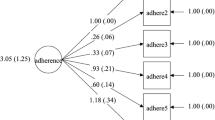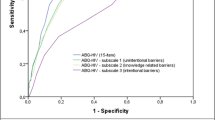Abstract
Background
Since the use of the questionnaire to evaluate adherence to HIV therapy (acronym CEAT-VIH) has increased in the last decade and translation into new language versions has been requested, summarizing information regarding the psychometric properties of the instrument may be useful for researchers and practitioners.
Objective
The purpose of this work was to review the psychometric properties of the questionnaire CEAT-VIH, available from published studies and research reports.
Data sources
Medline, PsycINFO, Google Scholar and Google; the searched period was from 2001 to 2012.
Study selection
Forty-eight research materials referring to the questionnaire CEAT-VIH were initially gathered from academic databases and direct contact with researchers, before being analyzed. From the initial pool of material compiled (i.e., abstracts, technical reports or database files, dissertations or complete articles), only 20 comprised original data.
Study appraisal and synthesis methods
The selected research material described a variety of information in terms of the psychometric properties of the questionnaire. The results from the primary studies were then summarized in tables for evaluation, description and comparison.
Results
Thirteen out of 16 studies reported a Cronbach’s alpha value of above 0.70, supporting the internal consistency reliability of the CEAT-VIH questionnaire. No floor or ceiling effects were observed. Hypothesized relationships between the CEAT-VIH score and adherence-related variables (e.g., viral load, CD4+, compliance evaluated by physician or pharmacist, complexity of treatment and pill numbers) were observed, indicating validity evidence. Thus, variables expected to act as psychological risk factors for low adherence (e.g., stress, depression and anxiety) or protector factor (e.g., social support) to good adherence were observed. The scores of the questionnaire were also related to quality of life outcomes. Moreover, patients that received adherence intervention showed increased CEAT-VIH adherence scores. Sensitivity and specificity to correctly identify adherent patients with undetectable viral load were also observed for three studies.
Limitations
Although the data provided in the reports were heterogeneous, these were valuable and reported enough evidence of validity for the instrument. The selected studies represented 41.7 % of those initially identified, and only eight out of 20 documents were peer reviewed.
Conclusions
The CEAT-VIH has been used for a variety of individuals of different ages, sex, socioeconomic and educational backgrounds. It has been a reliable and valid tool in measuring adherence to HIV treatment among different samples, and has been used with a wide range of study populations and countries (i.e., Brazil, Chile, Colombia, Mexico, Panama, Peru, Portugal, Puerto Rico, Romania and Spain). Encouraging data reported here may allow the recommendation of the CEAT-VIH as a valuable measure to use in HIV adherence research, especially in countries where the questionnaire already has available psychometric evidence.

Similar content being viewed by others
References
Haynes RB, Taylor DW, Sackett DL, editors. Compliance in health care. Baltimore (MD): Johns Hopkins University Press; 1979.
Remor E. Predictors of treatment difficulties and satisfaction with haemophilia therapy in adult patients. Haemophilia. 2011;17:e901–5. doi:10.1111/j.1365-2516.2011.02578.x.
Bezreh T, Laws MB, Taubin T, Rifkin DE, Wilson IB. Challenges to physician-patient communication about medication use: a window into the skeptical patient’s world. Patient Prefer Adherence. 2012;6(1):11–8. doi:10.2147/PPAS25971.
Kahana SY, Rohan J, Allison S, Frazier TW, Drotar D. A meta-analysis of adherence to antiretroviral therapy and virologic responses in HIV-infected children, adolescents, and young adults. AIDS Behav. 2013;17(1):41–60. doi:10.1007/s10461-012-0159-4.
Casotti1 JAS, Mendes AAS, Endlich BN, Queiroz MD, Tartaglia RS, Motta TQR. Factors associated with adherence to HAART in patients with HIV/Aids. DST J bras Doenças Sex Transm. 2011;23(4):215–21. doi:10.5533/2177-8264-201123412.
Flash C, Krakower D, Mayer KH. The promise of antiretrovirals for HIV prevention. Curr Infect Dis Rep. 2012;14(2):185–93. doi:10.1007/s11908-012-0242-z.
Holtgrave DR, Maulsby C, Wehrmeyer L, Hall HI. Behavioral factors in assessing impact of HIV treatment as prevention. AIDS Behav. 2012;16(5):1085–91. doi:10.1007/s10461-012-0186-1.
Cohen MS, Chen YQ, McCauley M, et al. Prevention of HIV-1 infection with early antiretroviral therapy. Engl J Med. 2011;365:493–505. doi:10.1056/NEJMoa1105243.
Heiby EM, Frank MR. Compliance with medical regimes. In: O’Donohue WT, Fisher JE, editors. Cognitive behavior therapy: applying empirically supported techniques in your practice. 2nd ed. Hoboken: Wiley; 2008. p. 109–15.
Haubrich RH, Little SJ, Currier JS, et al. The value of patient-reported adherence to antiretroviral therapy in predicting virologic and immunologic response. California Collaborative Treatment Group. AIDS. 1999;13(9):1099–107.
Chesney MA, Ickovics JR, Chambers DB, et al. Self-reported adherence to antiretroviral medications among participants in HIV clinical trials: the AACTG adherence instruments. AIDS Care. 2000;12(3):255–66. doi:10.1080/09540120050042891.
Remor E. Assessment of adherence to antiretroviral therapy in HIV+ patients (in Spanish). Psicothema. 2002;14(2):262–7.
Godin G, Gagné C, Naccache H. Validation of a self-reported questionnaire assessing adherence to antiretroviral medication. AIDS Patient Care STDS. 2003;17(7):325–32. doi:10.1089/108729103322231268.
Murri R, Ammassari A, Trotta MP, et al. Patient-reported and physician-estimated adherence to HAART: social and clinic center-related factors are associated with discordance. J Gen Intern Med. 2004;19(11):1104–10.
Wiener L, Riekert K, Ryder C, Wood LV. Assessing medication adherence in adolescents with HIV when electronic monitoring is not feasible. AIDS Patient Care STDS. 2004;18(9):527–38. doi:10.1089/apc.2004.18.527.
Muñoz-Moreno JA, Fumaz CR, Ferrer MJ, et al. Assessing self-reported adherence to HIV therapy by questionnaire: the SERAD (Self-Reported Adherence) study. AIDS Res Hum Retroviruses. 2007;23(10):1166–75.
Segeral O, Madec Y, Ban B, et al. Simplified assessment of antiretroviral adherence and prediction of virological efficacy in HIV-infected patients in Cambodia. AIDS Res Treat. 2010;2010:142076. doi:10.1155/2010/142076.
Simoni JM, Kurth AE, Pearson CR, Pantalone DW, Merrill JO, Frick PA. Self-report measures of antiretroviral therapy adherence: a review with recommendations for HIV research and clinical management. AIDS Behav. 2006;10:227–45. doi:10.1007/s10461-006-9078-6.
Remor E, Milner-Moskovics J, Preussler G. Brazilian adaptation of the Assessment of Adherence to Antiretroviral Therapy Questionnaire (in Portuguese). Rev Saude Publica. 2007;41(5):685–94. doi:10.1590/S0034-89102006005000043.
Giovelli GRM. Relationship between symptoms of depression, social support, quality of life and treatment adherence in people living with HIV/AIDS (In Portuguese; Master’s thesis). Porto Alegre (Brazil): Pontifícia Universidade Católica do Rio Grande do Sul; 2009.
Ücker-Calvetti P. Predictive biopsychosocial factors of adherence and quality of life in people living with HIV/AIDS with success in health care (In Portuguese; dissertation). Porto Alegre (Brazil): Pontifícia Universidade Católica do Rio Grande do Sul; 2010.
Carvalho CML. Prospective assessment of health parameters in HIV patients through nursing consultation (In Portuguese; dissertation). Fortaleza (Brazil): Universidade Federal do Ceará; 2010.
Flores-Rojas SN, Guinossi-Cerda GE, Pérez-Aguilera PM, Zepeda-Cabrera MM. Factors of adherence to drug therapy in young adults aged 20 to 50 years of age with HIV/AIDS: control and monitoring in the ‘San Juan de Dios La Serena’ Hospital (In Spanish; habilitation thesis]. La Serena (Chile): Universidad Santo Tomás; 2011.
Villa-González IC. Quality of life, adherence to therapy and psychosocial modulator variables in people living with HIV (In Spanish; Master’s thesis). Medellín (Colombia): Universidad de San Buenaventura; 2005.
Sanchez-Roman S, Baranda-Sepúlveda J, González-de-Jesús L, Jaime-Velasco D. Database of HIV therapy adherence assessment in Mexico. Mexico: National Institute of Medical Sciences and Nutrition Salvador Zubiran; 2008. (Data on file).
Pinzón-Visuetti Y. Coping with HIV/AIDS and adherence to antiretroviral therapy (In Spanish; habilitation thesis). Panama (Panama): Universidad de Panamá; 2008.
Reis AC, Lencastre L, Guerra MP, Remor E. Portuguese adaptation of the Questionnaire to assess adherence to antiretroviral treatment—HIV (CEAT-VIH) (in Portuguese). Psicol Saude Doenças. 2009;10(2):175–91.
Reis AC, Lencastre L, Guerra MP, Remor E. Relationship among psychopathological symptoms, treatment adherence and quality of life in HIV/AIDS infection (in Portuguese). Psicol Reflex Crit. 2010;23(3):187–96.
Tafur-Valderrama E, Ortiz C, Alfaro CO, García-Jiménez E, Faus MJ. Adaptation of the “Assessment of Adherence to Antiretroviral Therapy Questionnaire” (CEAT-VIH) for its use in Peru. ARS Pharm. 2008;49(3):183–98.
Alcántara-Zapata NR. Depressive symptoms and adherence to treatment in patients infected with HIV (In Spanish; habilitation thesis). Lima (Peru): Pontificia Universidad Católica del Perú; 2008.
Rivas-Rivas JE. Therapeutic adherence to highly active antiretroviral therapy and social support in a group of patients with HIV or AIDS (In Spanish; habilitation thesis). Lima (Peru): Pontificia Universidad CatólicadelPerú; 2008.
Dima A, Schweitzer AM, Diaconita R, Remor E, Wanless R. Adherence to ARV medication in Romanian young adults: self-reported behaviour and psychological barriers. Psychol Health Med. 2012; doi:10.1080/13548506.2012.722648.
Vasquez-Bernal C, Urbina ML. Database of HIV therapy adherence assessment in Colombia. Colombia: Corporación Milagroz; 2010. (Data on file).
Lausell-Gonzalez MZ. Association between depressive symptoms and adherence to antiretroviral therapy in people living with HIV or Aids in small towns of the region of south of Puerto Rico (in Spanish; dissertation). Ponce (Puerto Rico): Ponce School of Medicine & Health Sciences; 2012.
Ortiz F, Martinez-Donate A, Remor E, Arranz P. Database of antiretroviral treatment adherence in hemophilia HIV+ Spanish patients. Spain: University Hospital La Paz of Madrid; 2002. (Data on file).
Tafur-Valderrama EJ, Ortiz-Alfaro C, García-Jiménez E, FausDader MJ, Martínez Martínez F. Pharmacist intervention in the improvement of adherence in HIV/AIDS patients with antiretroviral treatment in Lima (Peru). Pharm Care Esp. 2012;14(4):146–54.
Urbina S. Essentials of psychological testing. Hoboken: Wiley; 2004.
Voils CI, Hoyle RH, Thorpe CT, Maciejewski ML, Yancy WS Jr. Improving the measurement of self-reported medication nonadherence. J Clin Epidemiol. 2011;64(3):250–4.
Raykov T, Marcoulides GA. Introduction to psychometric theory. New York: Routledge Academic; 2011.
Kaplan RM, Saccuzzo DP. Psychological testing principles, applications and issues. Belmont: Thompson Wadsworth; 2005.
Bollen K, Lennox R. Conventional wisdom on measurement: a structural equation perspective. Psychol Bull. 1991;110:305–14. doi:10.1037/0033-2909.110.2.305.
Remor E, Penedo FJ, Shen B-J, Schneiderman N. Perceived stress is associated with CD4 + cell decline in men and women living with HIV/AIDS in Spain. AIDS Care. 2007;19(2):215–9. doi:10.1080/09540120600645570.
Thirumurthy H, Siripong N, Vreeman RC, et al. Differences between self-reported and electronically monitored adherence among patients receiving antiretroviral therapy in a resource-limited setting. AIDS. 2012;26(18):2399–403. doi:10.1097/QAD.0b013e328359aa68.
Mills EJ, Nachega JB, Buchan I, Orbinski J, Attaran A, Singh S, Rachlis B, Wu P, Cooper C, Thabane L, Wilson K, Guyatt GH, Bangsberg DR. Adherence to antiretroviral therapy in sub-Saharan Africa and North America: a meta-analysis. JAMA. 2006;296(6):679–90.
Wendel CS, Mohler MJ, Kroesen K, Ampel NM, Gifford AL, Coons SJ. Barriers to use of electronic adherence monitoring in an HIV clinic. Ann Pharmacother. 2001;35(9):1010–5.
Acknowledgments
The author thanks all researchers and professionals that included the CEAT-VIH questionnaire in their research, and for providing the information and materials requested.
Disclosures
E. Remor is the author of the CEAT-VIH questionnaire.
Author information
Authors and Affiliations
Corresponding author
Rights and permissions
About this article
Cite this article
Remor, E. Systematic Review of the Psychometric Properties of the Questionnaire to Evaluate the Adherence to HIV Therapy (CEAT-VIH). Patient 6, 61–73 (2013). https://doi.org/10.1007/s40271-013-0009-0
Published:
Issue Date:
DOI: https://doi.org/10.1007/s40271-013-0009-0




